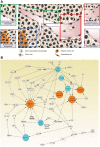Tumor cell intravasation
- PMID: 27076614
- PMCID: PMC4967137
- DOI: 10.1152/ajpcell.00238.2015
Tumor cell intravasation
Abstract
The process of entering the bloodstream, intravasation, is a necessary step in the development of distant metastases. The focus of this review is on the pathways and molecules that have been identified as being important based on current in vitro and in vivo assays for intravasation. Properties of the vasculature which are important for intravasation include microvessel density and also diameter of the vasculature, with increased intravasation correlating with increased vessel diameter in some tumors. TGFB signaling can enhance intravasation at least in part through induction of EMT, and we discuss other TGFB target genes that are important for intravasation. In addition to TGFB signaling, a number of studies have demonstrated that activation of EGF receptor family members stimulates intravasation, with downstream signaling through PI3K, N-WASP, RhoA, and WASP to induce invadopodia. With respect to proteases, there is strong evidence for contributions by uPA/uPAR, while the roles of MMPs in intravasation may be more tumor specific. Other cells including macrophages, fibroblasts, neutrophils, and platelets can also play a role in enhancing tumor cell intravasation. The technology is now available to interrogate the expression patterns of circulating tumor cells, which will provide an important reality check for the model systems being used. With a better understanding of the mechanisms underlying intravasation, the goal is to provide new opportunities for improving prognosis as well as potentially developing new treatments.
Keywords: EGFR; TGFB; angiogenesis; intravasation; metastasis; uPA.
Copyright © 2016 the American Physiological Society.
Figures


References
-
- Aceto N, Bardia A, Miyamoto DT, Donaldson MC, Wittner BS, Spencer JA, Yu M, Pely A, Engstrom A, Zhu H, Brannigan BW, Kapur R, Stott SL, Shioda T, Ramaswamy S, Ting DT, Lin CP, Toner M, Haber DA, Maheswaran S. Circulating tumor cell clusters are oligoclonal precursors of breast cancer metastasis. Cell 158: 1110–1122, 2014. - PMC - PubMed
-
- Alitalo K, Carmeliet P. Molecular mechanisms of lymphangiogenesis in health and disease. Cancer Cell 1: 219–227, 2002. - PubMed
-
- Asangani IA, Rasheed SA, Nikolova DA, Leupold JH, Colburn NH, Post S, Allgayer H. MicroRNA-21 (miR-21) post-transcriptionally downregulates tumor suppressor Pdcd4 and stimulates invasion, intravasation and metastasis in colorectal cancer. Oncogene 27: 2128–2136, 2008. - PubMed
Publication types
MeSH terms
Substances
Grants and funding
LinkOut - more resources
Full Text Sources
Other Literature Sources
Research Materials
Miscellaneous

